Some say drip irrigation is the best. I half agree. I’d modify it to say that drip, including its cousin the micro-sprinkler, is better than other methods of irrigation for many situations, but that it does come with its own set of downsides and challenges.
Yet I use it in most of my own yard, have for many years, on vegetables and fruit trees and, at least for me, its positives outweigh its negatives. The main reason I see drip irrigation in such a positive light is that I’ve learned to work around its weaknesses. That’s what I’m hoping to help you do in this troubleshooting guide.
I teach workshops on using drip irrigation from time to time — in fact, I’ll be doing one tomorrow down at the Tijuana River Valley Community Garden — and I use this guide as a handout. In it, I try to be both brief and clear, but I recognize that many terms may not be familiar, so in this digital version I’ve linked to some images and descriptions (in blue). Here we go . . .
Installing
–Warmth makes materials easier to work with so lay materials in sun, or
–Fill mug with hot water; dip tube end into, or
–Heat tube with match or lighter
–Tools can make work much easier: a gun puncher and a barb insertion tool might be worth the money
Clogging
—Filters are first line of defense
—Micro-sprinklers: run at high pressure briefly to blast out debris; poke with toothpick; use large orifice models, as they clog less often
–Last emitter on line often clogs first; cut off and connect new segment with emitter
–Flush lines periodically by opening end, especially after repairing or adding new emitters/lines
–Set automatic timer to run system while you are normally around to observe (not the middle of the night)
–Larger “half inch” tubing (thick as a carrot) clogs less often than smaller “quarter inch” tubing (as thick as a pencil)
Watering Plants with Different Needs
–Using emitters or micro-sprinklers with different water volume outputs allows plants with different water needs to be watered on same schedule (i.e. same valve/station), or
–Use multiple emitters or micro-sprinklers on bigger/thirstier plants
–New vegetable or tree added? Handwater to supplement if necessary; vegetable will grow roots into surrounding soil after one or two weeks; tree will take one or two months; be sure emitter is directly over rootball at first (yet best to not touch stem)
–Be not beholden to your drip system: For example, overhead water for carrot seed germination; occasionally spray potato foliage with hose to clean and prevent mites
–Adding inline shut-off valves gives increased flexibility; can add one to a line that serves one plant only or a line that serves multiple plants, and then adjust to control water flow
Run Times and Frequencies
–Most common error is not running system long enough at any one time
–Variables that affect how long and often to run system include: emitter output (higher output = less time needed); number of emitters per plant (more emitters = less time needed); soil type (sandier soil = less time needed, but needed more often because of less water-holding capacity); season (summer = more often, and winter = less often, but note that run time need not change); plants (avocados need more water than grapes); weather (heat wave makes plants thirstier); climate (plants inland need more water than plants near beach)
–Because of numerous variables, always observe and adjust; dig to discover truth of soil moisture where the roots are
–Don’t water again if soil still wet; don’t water so much that penetrates far below roots
–But for reference: Drip on vegetables for me have done well running system for approximately 45 minutes each time; in summer, at highest frequency, about every other day, but every two weeks in winter; my drip lines are 0.5 gallon per hour emitters spaced nine inches apart; soil is sandy loam; location is Ramona, twenty miles from ocean
–And for reference: Micro-sprinklers on fruit trees for me have done well running system for approximately two to four hours each time; in summer, at highest frequency, it’s about every 2-3 days for avocados, 3-5 days for citrus, 7-10 days for deciduous fruit trees
–Note that trees less than one year in ground need water more often than above
–Use tuna cans to estimate sprinkler output in inches; use a bucket (place sprinkler inside) to measure output in gallons
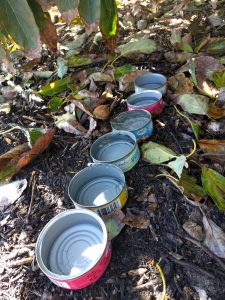
Tuna cans measuring micro-sprinkler output under fruit tree. A tuna can is about an inch deep. Note how the sprinkler has filled the middle cans first.
Miscellaneous Challenges
–Changing where water is applied is easiest on plants if done in late winter through early spring; plants may die if done in summer or early fall
–Slopes and uneven output: use pressure-compensating emitters, or; plant thirstier plants lower; water as infrequently but deeply as possible; install backflow prevention valve
–Slopes and runoff: first moisten soil surface with 1-3 minute pre-irrigation; slightly bury dripline; locate emitters and sprinklers uphill from plants; add coarse wood-chip mulch
–Sandy soil and raised beds: emitters must be spaced no farther than 12 inches to avoid “chimneys”
–Can test lateral spread of water in your soil by filling milkjug with water, poking hole near bottom, then after a day, digging to discover
–Fittings come apart: pressure might be too high; install regulator or manually keep low at faucet
–Tripping hazard: bury tube; stake to prevent snaking and rising; insert wooden stake beside sprinkler

Wood stake to indicate and protect micro-sprinkler on fruit tree. Stake has ancillary benefit of preventing the trunk from getting soaked, which helps prevent certain diseases.
There’s a lot more to drip irrigation, of course, but those are the most commonly challenging topics as far as my experience goes.
Would you like a copy? Click on this link for a pdf download of the handout version: “Drip Irrigation Troubleshooting Guide.” This version is two pages long and doesn’t include the introduction or any photos. It’s just the meat. But feel free to keep it on your computer or phone, print it and post it in your shed, photocopy it and give it to a gardener friend.
You might also like to read my other posts:

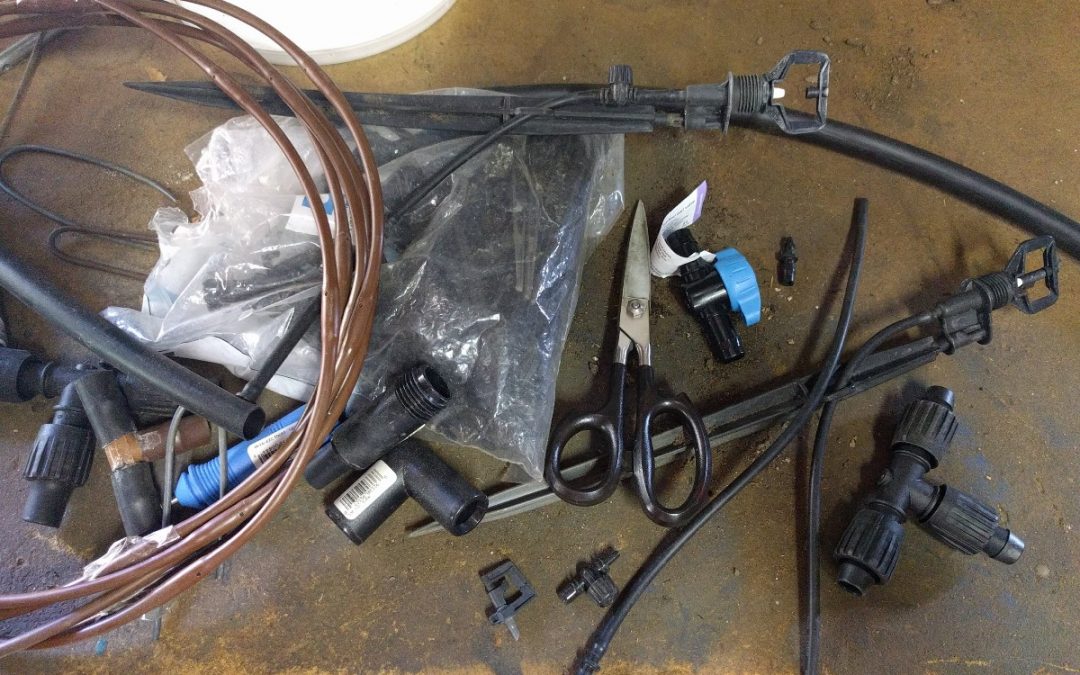
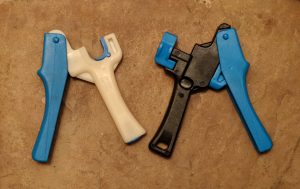
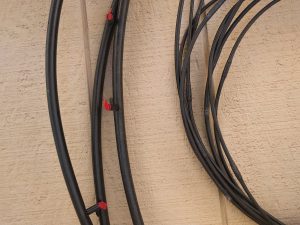
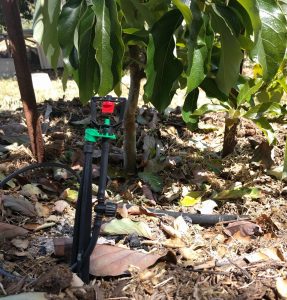
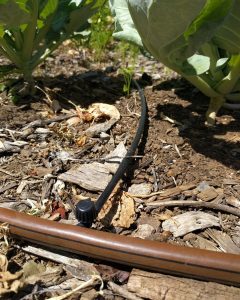


Very helpful info! I find irrigation to be the most challenging aspect of gardening (trying to balance water conservation with fruit/vegetable productivity) and really appreciate all the information you have on your website on that subject. I’m currently in the process of switching over to micro-sprinklers on my fruit trees based on your advice since they don’t seem to be thriving with the drip emitters I have set up for them (I live in Pasadena and my sandy loam soil seems similar to what you have written about yours).
For vegetables this year I am experimenting with ollas for watering. Do you have any experience with those?
Hi Heath,
I completely agree. I’m constantly trying to find the sweet spot where I water plants such that they thrive yet don’t waste any.
I hope you find better results with micro-sprinklers. Citrus and deciduous fruit trees have not seemed to care much whether they get water from drip or sprinkler in my soil. They did fine on drip lines, and they do fine now on micro-sprinklers. But my avocados do seem to appreciate the broader wetted soil volume that comes with sprinklers.
I’ve never used ollas. The closest I’ve come is punching a hole in a milk jug. Tell us how it goes with the ollas later in the summer.
Hello, I live in Ramona and I recently had the unfortunate event of seeing my avo trees go through the heat wave. I have 3 trees, Bacon, Hass and Zutano. I just painted them but feel it might be a struggle for them. I see new green growth on 2 but barely anything on the Bacon. Should feeding (gro power) them out of cycle help in the regeneration process.
Hi Aaron,
Glad you asked. Now is probably not a good time to fertilize those trees. Here is what avocado farm advisor Ben Faber says about this: “There’s probably sufficient nutrients in the soil from prior fertilization that nothing new needs to be applied.” See his full blog post about recovering avocado trees from this horrible heat wave here: http://ucanr.edu/blogs/blogcore/postdetail.cfm?postnum=27676
I appreciate your suggestions. I enjoy reading your posts!
I love you, Mom. Happy Mother’s Day!
Greg,
Question on the drip nozzles popping off and giving me water wiggles in the garden. Looking into pressure reducer, but this only happens in one of the three zones. Is there a quick clamp I can put on to hold the nozzles onto the hose?
It’s been hot in Santee. 7:00am start.
Tracy
Hi Tracy,
By “nozzles” are you referring to the sprayers that spray the water onto your plants? Are they what’s popping off?
Hi Greg,
It’s true your posts are very helpful indeed. You did not mention bubblers. Is there a reason? It looked to me, from my Googling, like they might be the easiest for fruit trees since you can turn them up and down with a turn off the cap and it looked as if they would clog less. I have just planted several fruit trees, mostly citrus, but one fruit salad tree and, hum, a Spice Zee Nectaplum 🙂 Thanks again for that. So I am ready to take one of my zones and turn it into a dedicated drip system for all of my trees and want to do the “right” thing. I am starting to look into Micro Sprinklers now since you mentioned them. Also is there a brand you prefer in drip systems?
TIA… Steven
Hi Steven,
Thanks for mentioning bubblers. They certainly work well on fruit trees in most situations; my neighbor has about a dozen citrus trees growing great on bubblers. They don’t work so well on slopes, however, because you have to dig out a basin for them. And I didn’t include them in this post because I don’t think of them as drip or micro irrigation components. Bubblers can put out a lot more volume than typical drip emitters or micro-sprinklers.
There is no “right” way to irrigate fruit trees, generally. In my own yard, I use different methods on different trees. The most important thing is how you use each method. For example, if using drip you need to make sure that you water more frequently than you would have to with sprinklers.
If you have a dedicated zone to just your fruit trees, then one thing you will find convenient is using the same method on all the trees. This isn’t necessary, but it can be convenient in order to be efficient and accurate and adjust easily going forward. For example, I have all of my grapes on one zone and they are all on drip whereas I have another zone for my avocados and they are all on micro-sprinklers.
If your land is flat, use any method. If it’s on a slope, use drip or micro-sprinklers because they are less likely to result in runoff. I’ve found that every type of fruit tree can grow well on every method.
I’ve used many brands and I’ve found that they all work satisfactorily.
I am interested in your experience with blocked micro-spray sprinklers with ants or slugs etc:
In Riverland Australia, it appears to be a big issue and orchardists need to ride up and down rows with bamboo to tap the blocked sprinklers and wear rain gear to get off their quad bikes to unblock or change over the sprinklers?
Hi Neil,
I deal with this on some of my micro-sprinklers too. In my case, it’s strictly ants causing the problem. I have started using pressure-compensating micro-sprinklers on some trees and haven’t had any such clogging on them yet. These PC micro-sprinklers totally close up when the system stops running so the ants can’t enter (theoretically, anyway). These are the ones I’m using: https://www.dripdepot.com/product/jain-pressure-compensating-micro-sprinkler
Thanks for your reply. Most interesting as I have been designing an Anti Ant and Anti Dust Pop up Posidrive sprinkler for some time and only now have I started getting back into it. Having researched issues with under tree orchard sprinklers I hope I can create a better device soon. Cheers for your assistance.
Great post on irrigation troubleshooting, thanks for sharing!
These posts on irrigation are very helpful, thanks Greg.
I’ve started assembling a system to apply drip irrigation to our yard, which has a dozen or so fruit trees, grape vines, kiwis, passionfruit, & raspberry bushes. These were all planted a year or two ago and now have canopies around 3-5′ wide. I’ve been handwatering them with a hose all along.
You suggest here that “Changing where water is applied is easiest on plants if done in late winter through early spring; plants may die if done in summer or early fall”. Should I wait until the rainy season hits to start to use the drip, or is there a good way to “wean” the trees from handwatering over to the drip system?
Good question, Steve. You can wean the trees by running the drip but continuing to handwater intermittently too. If the drip irrigation is being applied in the same area where you had been handwatering, then the trees will make the transition quickly and without stress. But if not, then you’ll need to draw out the weaning process longer.
hi i live 5 miles northwest of Ramona. have 3.,4 acres on side of large hill. my soil seems not loamy my problem is that all my adjustable sprinklers seem to change from day to day some slow way doiwn and some speed up, and they vary they all seem to do both. we have well water so i know i need to change them often. but even new one do this is their a better brand than the normal ones that are relatively cheap? don’t mind paying more
Hi Wesley,
A few things that could be causing the output of sprinklers to vary, along with solutions:
1. Changes in pressure- add a pressure regulator, use pressure-compensating sprinklers (which aren’t perfect but do help a bit), irrigate when water is not being pulled to other places (such as other irrigation stations, clothes washing machine, shower)
2. Clogging- add a filter, check and clean the filter
3. Don’t use adjustable sprinklers- use fixed-output sprinklers instead, as adjustable sprinklers tend to adjust themselves sometimes
There are lots of high-quality brands of sprinklers. Generally, you get what you pay for. Head down to Grangetto’s in Escondido, and they can get you some good ones.